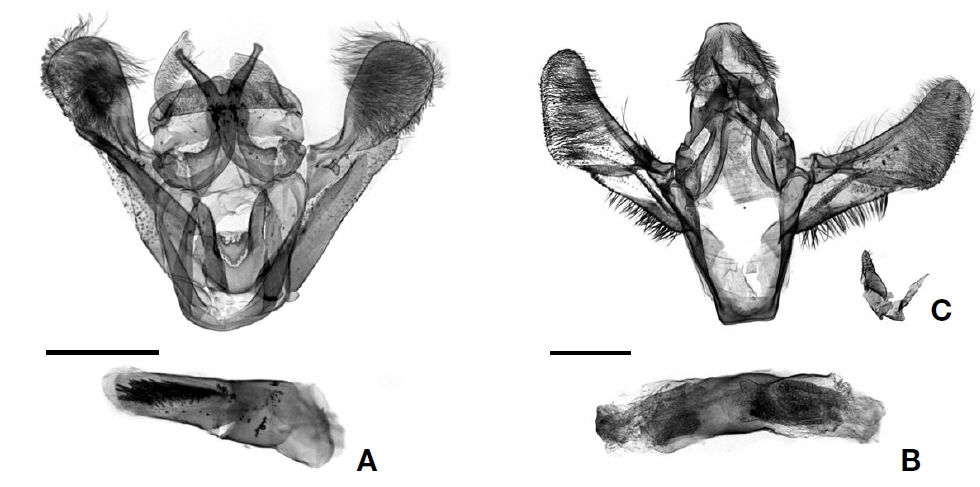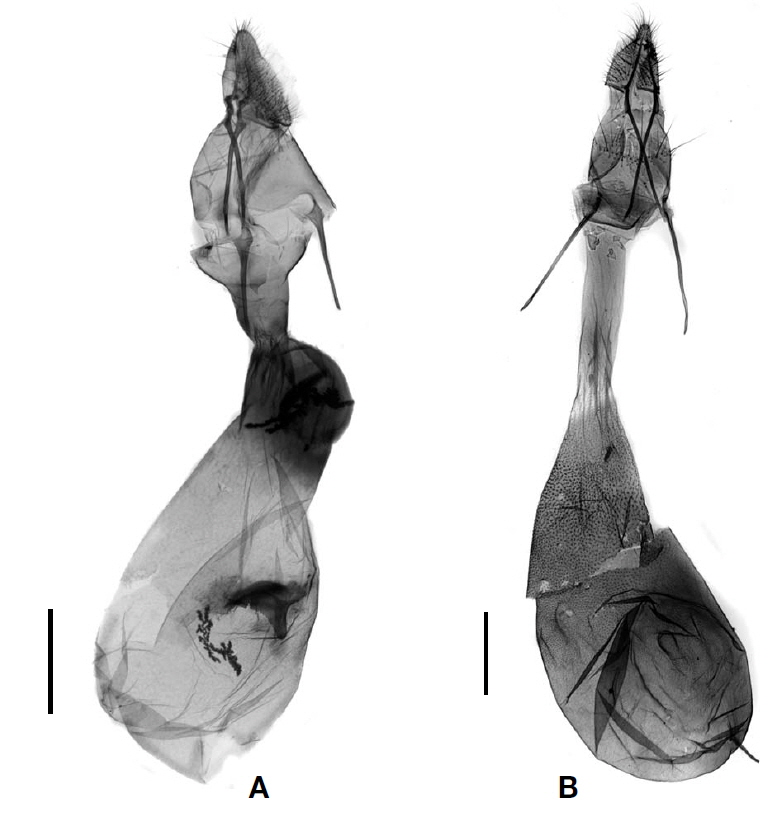



The Phycitinae are one of the largest subfamilies of the family Pyralidae in Lepidoptera, comprising approximately 5,000 species in the world (Li and Ren, 2009). Leech and South (1901) first reported 3 species of Phycitini from the Korean Peninsula; Okamoto (1924), Shibuya (1927), Park and Lee (1958), Park (1976, 1983, 1993), Byun et al. (1997), Choi et al. (1998, 1999), Paek et al. (1999, 2002), Paek and Bae (1999, 2000, 2001a, 2001b), and Byun and Lee (2008), respectively, made contributions to the faunal study of Korean Phycitinae. Currently, Bae et al. (2008) reviewed the subfamily with 79 known species from South Korea. In the present study, the authors add two more Phycitinae species for the fauna of Korea:
Order Lepidoptera Linnaeus, 1758
Family Pyralidae Latreille, 1809
Subfamily Phycitinae Ragonot, 1885
Genus
Material examined. Korea: 1♂, GW, Sokcho, Jeohangryeong, 7 Jul 2003, Bae et al., Slide No. UIK-3333; 1♀, GG, Gangneung, Lake Yuklim, 21 May 2012, legs Park SY, Lim JO, Lim JS, 37°44′54.73′′N, 127°9′50.09′′E, Slide No. KN AE344033; 1♀, GW, Inje-gun, Girin-myeon, Mt. Jeombongsan, 4 Jul 2011, 735 m, legs Lim JO, Kim KM, 38°02′20.8′′ N, 128°28′17.7′′E, Slide No. KNAE291607.
Diagnosis. There is no species similar to
Adult (Fig. 1A). Wingspan 15-18 mm. Frons pale grayish-brown; labial palpus fuscous and upturned, 2nd and 3rd segment same length, inner side with white scales; maxillary palpus grayish-white, about 1/3 length of 3rd segment of labial palpus; proboscis covered with white scales; antenna fuscous, scape enlarged, dorsal part grayish-white. Thorax, patagium and tegula grayish-brown. Forelegs with femur white, tibia and tarsus fuscous; midlegs with femur and tibia white, mixed with brown, tarsus pale brown; hindlegs with femur and tibia white, mixed with brownish-gray scales, tarsus pale brown, inner side and tip with pale gray scales. Forewing with ground color brownish-gray; antemedial line grayish-white, straight, oblique outwardly from 1/3 of costa, bordered distally by broad reddish-yellow band; postmedial line grayish-white, sinuous, inside distally bordered by short reddish-brown spots; median area with grayish scales near costal area; distal discoidal spots two, fuscous; terminal grayish- white, interneural spots black, subterminal area suffused with gray scales; fringe pale grayish-brown. Hindwing pale gray, terminal line and fringe pale brown.
Male genitalia (Fig. 2A). Uncus semicircular; gnathos bifurcate apically, each arm finger-shaped, slightly longer than uncus, rounded in the end; transtilla connected as rectangular, terminal margin rather flat; valva rounded at apex, costa enlarged as triangular; sacculus about 2/3 length of valva; juxta U-shaped, lateral lobes as long as gnathos; vinculum rather short; saccus rounded; aedeagus short, about 1/2 length of valva, narrow at apex, cornutus formed by numerous thornshaped sclerites.
Female genitalia (Fig. 3A). Apophyses anteriores stout, about 1/2 length of apophyses posteriores; antrum cup-shaped, well-sclerotized; ductus bursae rather short; corpus bursae oblong, about 4 times as long as antrum; signum well-sclerotized, rather big, coniform, basal part enlarged.
Distribution. Korea (new record), Japan, Russia.
Genus
Material examined. Korea: 2♂, GW, Pyungchang-gun, Mahari, 6 Jun 1996, legs Lee JS, Slide No. UIK-3336, 3337; 1♂2♀, GW, Youngweoul-eup, Moonsan-ri, 7 Jun 1996, legs Park YM, Slide No. UIK-3338, UIB-1957, 1958; 1♀, Yeongwoll-gun, Sangdong-eup, Mt. Jangsan, 21 Jul 2010, 1,006 m, legs Park SY, Lim JS, Kim KM, 37°08′02.4′′N, 28°52′03.6′′E, Slide No. KNAE184552.
Diagnosis. This species can be distinguished from
Adult (Fig. 1B). Wingspan 19-21 mm. Frons fuscous; vertex yellowish-brown, covered with long scales; labial palpus fuscous, slender and upturned, 2nd segment about 1.5 times of 3rd segment in length; maxillary palpus brownish-gray, slightly shorter than the 2nd segment of labial palpus; proboscis fuscous basally; antenna filiform and pale brown, less than 1/2 of the forewing, male scape swollen, and with 2 tooth-like projection. Patagium and tegula grayish-brown. Forelegs fuscous; midlegs fuscous, with tip of tibia grayish-white; hindlegs with femur and tibia grayish-white, tarsus pale gray. Forewing with ground color gray; antemedial line white, slightly convex outwardly, outside the line with dark band; postmedial line oblique from costa inwardly, convex outwardly in middle, postmedial line border with fuscous line on both sides; distal margin with a serious of black spots; apex tinted with dark brown; fringe pale brown. Hindwing pale white, without spots, fringe pale brown.
Male genitalia (Fig. 2B, C). Uncus triangular, slightly flat on top, lateral sides with hairs; gnathos slender, with sharped tip, about 1/2 length of uncus; distal part of valva with hairs, costa well-developed, broad at base 1/2; harpe at base of valva; sacculus sclerotized, about 1/2 length of valva, with thin bristles; juxta V-shaped, lateral lobe well-developed (Fig. 2C); vinculum U-shaped, length slightly longer than greatest width, terminal margin concave; aedeagus stout, cylindrical, slightly curved, cornutus absent.
Female genitalia (Fig. 3B). Apophyses anteriores and posteriores slender, almost equal; ostium bursae broad, sclerotized slightly; ductus bursae about 1.3 times as long as corpus bursae, posterior with granulated ventral surface; corpus bursae oval, membranous, signum peanut-shaped, in the middle of corpus bursae, composed of minute spines; ductus seminalis from the end of ductus bursae.
Distribution. Korea (new record), China, Japan (Hokkaido), Russia (Primorsk Terr.).


